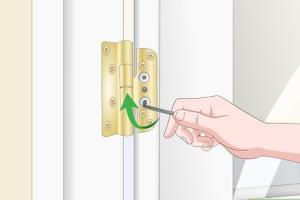Adjusting French Doors: Your Complete Guide to Common Issues and Solutions

-
Quick Links:
- Introduction
- Understanding French Doors
- Common Problems with French Doors
- Adjustment Techniques for French Doors
- Case Studies
- Expert Insights
- Maintenance Tips
- FAQs
- Conclusion
Introduction
French doors are a popular choice in homes due to their elegance and ability to connect indoor and outdoor spaces. However, over time, these beautiful doors can develop issues that may hinder their functionality. This comprehensive guide will help you understand how to adjust your French doors, tackle common problems, and maintain them for lasting beauty and utility.
Understanding French Doors
French doors typically consist of two doors that open outwards or inwards, allowing for ample natural light and a broader view. They are characterized by their multiple panes of glass, which can enhance the aesthetic appeal of any room. However, the construction of French doors makes them susceptible to certain issues over time.
Types of French Doors
- Single French Doors: A single door with glass panes, commonly used in smaller spaces.
- Double French Doors: Two doors that open together, ideal for wider openings.
- Sliding French Doors: A modern variant that slides open, providing a sleek look.
Common Problems with French Doors
1. Misalignment
One of the most common issues with French doors is misalignment, which can cause difficulty in opening and closing. This misalignment can occur due to changes in temperature, foundation settling, or improper installation.
2. Drafts and Leaks
Drafts around the edges of French doors can lead to energy loss and discomfort in your home. This is often caused by worn-out weather stripping or gaps due to misalignment.
3. Sticking or Binding
Doors that stick or bind are often a result of poor installation or swelling wood due to humidity. This can prevent the doors from closing fully or make them difficult to open.
Adjustment Techniques for French Doors
Step-by-Step Guide to Adjusting French Doors
Tools You’ll Need
- Phillips screwdriver
- Flathead screwdriver
- Level
- Tape measure
- Wood shims
Step 1: Assess the Door Alignment
Use a level to check if the door is aligned properly. Place the level on the top and sides of the door. If it’s not level, you’ll need to adjust it.
Step 2: Adjust the Hinges
Loosen the screws on the hinges slightly. If the door is sagging, add wood shims behind the hinge to lift it. Tighten the screws back down.
Step 3: Check the Strike Plate
If the door doesn't latch properly, inspect the strike plate. Adjust or reposition it as needed to ensure a secure latch.
Step 4: Replace Weather Stripping
If you notice drafts, check the weather stripping around the door. Replace it if it's worn out to improve energy efficiency.
Case Studies
Case Study 1: Resolving Misalignment in an Old Home
In a 1920s bungalow, the homeowners faced significant misalignment in their double French doors. After assessing the structure and foundation, they implemented a shim adjustment and replaced the weather stripping, which resolved the issue effectively.
Case Study 2: Drafty Doors in a New Build
A new homeowner discovered drafts in their French doors despite seemingly perfect installation. Upon inspection, it was found that the weather stripping was not installed correctly, leading to significant energy loss. Replacing the weather stripping eliminated the drafts completely.
Expert Insights
According to experts, regular maintenance of French doors can prevent many common issues. "Inspecting the hinges, weather stripping, and alignment every six months can save homeowners from larger problems down the line," says home improvement expert Jane Doe.
Maintenance Tips
- Regularly check the alignment and adjust as necessary.
- Clean the door frames and glass panes to prevent grime build-up.
- Lubricate hinges at least once a year.
- Inspect and replace weather stripping as needed.
- Check for signs of water damage or rot, especially in wooden doors.
FAQs
1. How often should I adjust my French doors?
It's recommended to check the alignment and condition of your French doors every six months.
2. Can I adjust my French doors myself?
Yes, with the right tools and guidance, you can adjust your French doors yourself.
3. What if my French doors are still sticking after adjustments?
If the doors continue to stick, you may need to investigate further for structural issues or consider professional help.
4. How do I know if my weather stripping needs replacing?
If you feel drafts around the door or notice visible wear and tear, it’s time to replace the weather stripping.
5. What tools do I need for adjusting French doors?
You will need a Phillips screwdriver, flathead screwdriver, level, tape measure, and wood shims.
6. Are French doors energy-efficient?
Yes, when properly installed and maintained, French doors can be quite energy-efficient, especially with the right weather stripping.
7. Can I install French doors myself?
While it’s possible to install French doors yourself, it’s recommended to hire a professional for best results, especially for larger doors.
8. How can I prevent my French doors from warping?
To prevent warping, ensure proper installation, avoid excessive moisture, and regularly inspect for damage.
9. Is it normal for French doors to sag over time?
Yes, sagging can occur due to changes in humidity and temperature or improper installation. Regular adjustments can help mitigate this.
10. What should I do if I notice mold around my French doors?
If you notice mold, clean it immediately with a suitable cleaning solution and ensure the area is well-ventilated to prevent future growth.
Conclusion
Adjusting and maintaining French doors doesn't have to be a daunting task. With the right tools and knowledge, you can solve common problems effectively and keep your doors functioning beautifully. Regular maintenance will not only enhance the longevity of your doors but also improve the overall comfort and energy efficiency of your home.